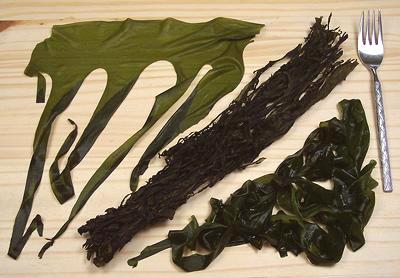 [Wakame (Japan); Miyeok (Korea); Qundaicai (China);
Undaria pinnatifida]
[Wakame (Japan); Miyeok (Korea); Qundaicai (China);
Undaria pinnatifida]
Wakame is a popular seaweed for soups and salads,particularly in Japan and Korea. its native region. It has become a troublesome invasive in New Zealand and some other places. It has also invaded California, but can't compete with native kelps. It is found here only in estuaries and disturbed places the native kelps haven't yet returned to.
It has a softly crunchy texture and a pleasant slightly spinachy flavor. While most familiar in North America as dry, brittle black tangles in plastic bags, it is also commonly available salted in bags in the refrigerated section of Korean markets.
The photo specimens are dried tangle (center), salted tangle briefly soaked (lower right) and a single piece from the salted tangle spread out (upper left). This is a short length cut from one side of the central stem.
Wakame has recently been found to contain a substance that stimulates production of a fat burning protein, so expect it to become better known in the West. It has become a troublesome invasive weed along the coasts of non-Asian countries, so eat up!
More on Algae.
In Korea and Japan, fresh Wakame is often available, and there is the salted, which has better color and texture than the dried, but most people use the dried most of the time, for economy and ease of storage. This is so prevalent, most recipes don't mention any form except dried.
Dried Wakame should be very dark greenish black. Any light spots or brownish black instead of greenish black means it is old and/or has been stored improperly. When soaked, it should be very dark green and of uniform color, but green, not black or brown or unevenly colored.